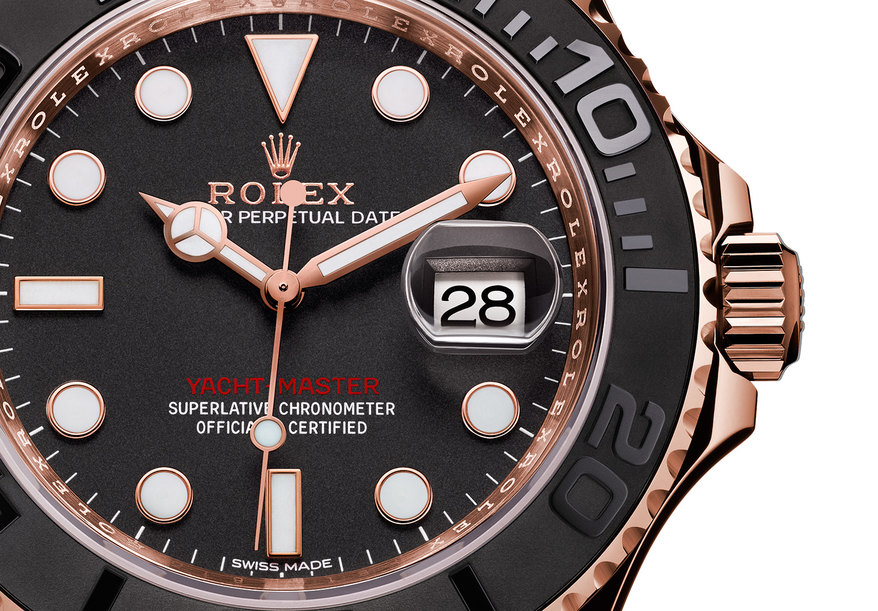
“Obsessed with perfection” is the very apt slogan of the highly
popular Rolex; a brand that has always been one of the most famous and
imitated in the world of watchmakers.
The history of this status symbol originates with its official German
founder, Hans Wilsdorf. Having been involved with watchmaking since he
was a child, in 1905, at the age of 24, he decided to found his own
company in London. Known as “Wilsdorf & Davis”, it specialised in
manufacturing watch cases and the commercial distribution of
wristwatches.
From the very beginning, the young Wilsdorf understood the innovative
potential of a wristwatch and ordered from Herman Aegler (an excellent
watch manufacturer at that time), a huge quantity of watch movements.
He had such success that on 2nd July 1908 Wilsdorf registered the Rolex
brand name, whose official site was in “La Chaux de Fonds”. After
this, it was transferred to Bienne in 1912 and, in 1919, to Geneva
where it became “Montres Rolex Manufacture”. In 1926, Wilsdorf
registered the Rolex five-peaked crown, adopted as its official logo.
The origin of the term “Rolex” derives from the French idiomatic
expression “horlogerie exquise”; precious watchmaking. According to
others, however, the name was chosen as it can be easily pronounced in
many languages.
The story of the success of Rolex dates back to 1910 when a movement
created by the brand received the first official chronometer
certification awarded to a wristwatch by the Watch Making School in
Bienne. (This school would become one of the “Bureaux Suisses de
Controle Officiel de la Marche des Montres”).
In 1926, the patent of the “Oyster”was registered, the first
truly-waterproof watch case. As testimony of its impermeability,
Wilsdorf chose Mercedes Gleitz, the London swimmer to wear the Rolex
Oyster when she swam the Channel, which turned out to be in record
time.
In 1929, the Rolex “Prince” model was launched, followed by the Rolex
“Perpetual” in 1931. This model was equipped with an
automatically-wound rotor mechanism that increased the precision of the
Rolex watch.
In 1937, the first Rolex “Precision” model was released into the
market, and in 1941 saw the launch of the Female “Oyster Perpetual”
(reference 420). In 1945, the Rolex “Date Just” was created; the first
self-winding, water-resistant wrist-chronometer, which also showed the
date. In 1950, Rolex launched the “Turn-O-Graph”, followed by the Rolex
“Submariner”, which guaranteed water-resistance to the depth of 100
metres. In the same year, Sir Hedmund Hillary and Tenzing Norgay
conquered Everest whilst wearing a “Rolex Oyster Perpetual Explorer”.
In 1954, the Rolex “GMT Master” was created, which displays time
simultaneously in any two time zones. The Rolex “Milgauss” anti-magnetic
model was also released in this year.
The year 1956 marked the launch of the Rolex “Day-Date”, displaying the date and the day, available in 26 languages.
In 1959, Rolex launched the new “Rolex Submariner” (ref. 5513), which guaranteed water-resistance to a depth of 200 metres.
In 1963, three years after the death of Hans Wilsdorf, his favourite
apprentice, André Heiniger, took charge of the Rolex business.
Heiniger successful continued the positive philosophy of the company,
handing it on to his son Patrick, the Rolex company manager since 1992.
In 1960, Rolex launched into another “mission impossible” when it
anchored a special Rolex Oyster to the hull of the Trieste U.S. Navy
bathyscaphe. Here, the watch was dragged down to the bottom of the
Mariana Trench, the deepest oceanic trench in the world. The watch kept
on working, whilst going both down and back up, demonstrating the
excellence of the Swiss brand. Through such explorations, Rolex
endeavoured to show the reliability of its watches, whether put through
oceanic immersions, aviation or mountain climbing. It also formed a
bond between the company and the sporting world that exists to this
day.
Returning to a historical account of the brand, 1961 marked the
launch of: the “Rolex Cosmograph Daytona”, the first Oyster
chronograph (ref.6239), followed by the Oyster model (ref.6241). In
1971 the Rolex Sea-Dweller was created, the first watch that guaranteed
water-resistance to a depth of 610 metres (in 1980, the limit would
reach up to 1200 metres). This advance was possible thanks to a
helium valve which allowed the watch to decompress.
In the same year, the first Rolex Oyster Chronometer Daytona was
launched, with water-resistant and screw-down pushbuttons. This model
was initially made in steel, then in 14CT gold, and finally in 18CT
gold with a black (ref. 6263) or engraved (ref.6265) bezel.
A memorable year for Rolex was 1973 when Tom Sheppard wore a “Rolex
Oyster GMT Master” during the first crossing of the Sahara across
Majabat Al Kubra in Mauritania. This Rolex model thus demonstrated its
resistance to the hell-like Saharan temperatures and frequent
sandstorms.
In 1974, the Rolex Oyster Quartz was presented, with an 11-ruby quartz
movement and, in 1978, Reinhold Messner, whilst wearing this model,
peaked Everest with no oxygen mask.
The end of the 1970s records the first use of sapphire glass in a
Rolex watch, which initiated the production of the “Oyster Quartz”.
In 1983, Rolex launched the “GMT Master II” , with a rotating 24-hour
bezel, a 24-hour hand and an independently-adjustable 12-hour hand that
facilitated time reading in two time zones.
The year1988 marked the launch of the “Rolex Cosmograph Chronometer
Daytona”, (ref. 16520 made of steel, ref. 16523 steel and gold, and
ref. 16528 if only gold). This brand was marked with the “Zenith El
Primero” movement, the first integrated self-winding chronograph
movement which could measure time to a tenth of a second.
In 1992, two years after it had celebrated the production of its 10
millionth chronometer, Rolex presented the “Oyster Perpetual Date
Yacht-Master” (ref. 16628); an 18CT yellow gold chronometer with an
Oysterlock bracelet and safety clasp. In 1994, the “Yacht-Master”
series was created in a female equivalent (ref. 69628), which, in 1996,
was presented in a gold and steel version. In 1999, the “Rolex
Yacht-Master Rolesium” was launched, made of steel and platinum.
In 2005, the Prince model was launched, inspired by the 1929 original.
The Rolex catalogue is divided into three collections: “Oyster
Perpetual”, “Oyster Professional” and “Cellini”. The Oyster Perpetual
collection includes various models, distinctive in their design,
material, dial, and finer detailing. These include: Rolex Datejust, Rolex Turn-O-Graph, Rolex Perpetual, Rolex Day-Date, Rolex Pearlmaster, Rolex Air-King.
The Professional collection, linking sport with elegance, includes: Rolex Explorer, Rolex GMT-Master II, Rolex Daytona, Rolex Milgauss, Rolex Sea-Dweller, Rolex Yacht-Master, Rolex Submariner.
Finally, there is the Cellini collection, considered the most prestigious and luxurious: Rolex Cellinium, Rolex Quartz, Rolex Cellissima, Rolex Prince, Rolex Danaos, Rolex Cestello, Rolex Orchid.
In addition to these three main collections, you can also find the
special collections and the limited-edition Rolex watches, such as: Rolex Oyster 31mm, Rolex New Datejust Rolesor and the Rolex Submariner, which celebrates the 50th anniversary of the “green ring nut” Submariner model.
Among the most recent Rolex models the company has produced there is the “Yacht Master II”, created specifically for yachtsmen, equipped with an innovative system to countdown the minutes that precede the starting of a yacht race. This model is also the display for the main page of the Official Rolex website.
The Rolex website includes videos, photo galleries and a brief summary of the company’s philosophy.
The “Sport and Culture” section is fascinating, showing Rolex’s
participation in the world of art and sport (golf, horse-riding,
explorations, car racing, skiing, tennis and sailing) In total, Rolex
is the sponsor of more than 150 cultural and sport events throughout the
world.
Rolex is also the founder of the “Rolex Institute”, which supports the
world of science, culture, education and the arts. This includes the
“Rolex Awards for Enterprise”. Founded in 1976, the project encourages a
better handling of the Earth, as well as the “Rolex Mentor and Protégé
Arts” Initiative, founded in order to support emerging artists.
This memorable brand has also founded watchmaking schools in
Switzerland, Japan, and the United States. A school committed to
perpetuating excellence in watchmaking through carefully selected
apprentices. The website reads “Graduates are not obliged to work for
Rolex…”.


